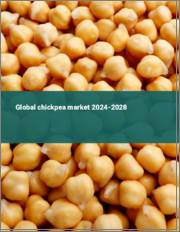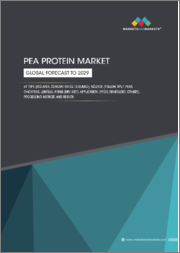
|
시장보고서
상품코드
1661262
병아리콩 시장 : 세계 산업 동향, 점유율, 규모, 성장, 기회 및 예측(2025-2033년)Chickpeas Market: Global Industry Trends, Share, Size, Growth, Opportunity and Forecast 2025-2033 |
||||||
세계의 병아리콩 시장 규모는 2024년 2,150만 톤에 달했습니다. IMARC Group은 2025년부터 2033년까지의 시장 성장률(CAGR)은 4.57%로 2033년에는 3,220만 톤에 달할 것으로 예측했습니다. 시장을 견인하는 요인으로는 간편하고 빨리 먹을 수 있는(RTE) 간식에 대한 수요 증가, 식물성 단백질에 대한 요구 증가, 건강과 웰빙에 중점을 둔 개인의 건강 의식 증가 등 다양한 것들이 있습니다.
가르반조 콩이라고도 알려진 병아리콩은 콩과에 속하며 파보이드과 아과에 속하는 콩과 식물을 말합니다. 재배되는 병아리콩에는 데시 종과 카브리 종의 두 유형가 있습니다. 데시 종은 인도 아대륙에서 재배되고, 카브리 종은 서아시아와 지중해 연안에서 재배됩니다. 병아리콩은 탄수화물, 단백질의 양질공급원이며,식이 섬유, 비타민, 미네랄을 많이 함유하고 있습니다. 그 결과, 혈당를 안정시키고, 근력을 유지하고, 체중 관리를 돕고, 소화를 개선하고, 당뇨병과 심장 발작과 같은 만성 질환의 위험을 최소화하는 등 많은 건강상의 이점이 있습니다. 따라서 소스, 딥, 수프, 스프레드 등 다양한 요리에 추가됩니다.
병아리콩은 채식주의자와 비건 소비자를 위한 경제적인 단백질 근원이고 인도 아대륙에서는 달 모양으로 널리 소모됩니다. 또한 병아리콩을 으깨서 만드는 딥, 후무스의 주원료로도 사용되어 세계 각지에서 사랑 받고 있습니다. 또한 최근에는 건강 의식이 높아짐에 따라 소비자가 단백질 함량이 높은 식품을 선택하게 되어 제품 수요를 더욱 밀어 올리고 있습니다. 채식주의 고기 대체 추세에 따라 병아리콩도 식감 단백질 생산에 사용됩니다. 게다가, 콩과 같은 고단백 소스는 높은 비용으로 이용가능성이 제한되어 있기 때문에 병아리콩은 저비용 사료 첨가물로서 상승했습니다. 시장 성장을 뒷받침하는 기타 요인으로는 인구 증가, 가처분 소득 증가, 식생활 패턴 변화 등이 있습니다.
이 보고서에서 다루는 주요 질문
- 2024년 세계의 병아리콩 시장 규모는?
- 세계의 병아리콩 시장 예상 성장률은?
- 세계의 병아리콩 시장을 견인하는 주요 요인은?
- 세계의 병아리콩 시장에 대한 COVID-19의 영향은?
- 세계의 병아리콩 시장의 주요 지역은?
- 세계의 병아리콩 시장의 주요 기업은?
목차
제1장 서문
제2장 조사 범위와 조사 방법
- 조사의 목적
- 이해관계자
- 데이터 소스
- 1차 정보
- 2차 정보
- 시장 추정
- 상향식 접근
- 하향식 접근
- 조사 방법
제3장 주요 요약
제4장 서론
- 개요
- 주요 업계 동향
제5장 세계의 병아리콩산업
- 시장 개요
- 시장 실적
- 수량 동향
- 금액 동향
- 가격 분석
- 주요 가격 지표
- 가격구조
- 가격 동향
- COVID-19의 영향
- 시장 분석 : 지역별
- 시장 예측
- 무역 데이터
- 수입 : 주요 국가별
- 수출 : 주요 국가별
- SWOT 분석
- 개요
- 강점
- 약점
- 기회
- 위협
- 밸류체인 분석
- 투입물 공급업체
- 농민
- 수집가
- 생산업체
- 유통업체
- 수출업체
- 소매업체
- 최종 사용자
- Porter's Five Forces 분석
- 개요
- 구매자의 협상력
- 공급기업의 협상력
- 경쟁도
- 신규 참가업체의 위협
- 대체품의 위협
- 시장 성장 촉진요인과 성공 요인
제6장 주요 지역의 실적
- 인도
- 시장 동향
- 시장 예측
- 호주
- 시장 동향
- 시장 예측
- 파키스탄
- 시장 동향
- 시장 예측
- 미얀마
- 시장 동향
- 시장 예측
- 에티오피아
- 시장 동향
- 시장 예측
제7장 경쟁 구도
제8장 병아리콩 가공
- 제품 개요
- 세부 공정 흐름
- 다양한 유형의 단위 작업
- 질량 균형과 원재료 요구 사항
제9장 프로젝트의 세부 정보, 요구 사항 및 관련 비용
- 토지 요구 사항과 비용
- 건설 요구 사항과 비용
- 플랜트 기계
- 기계 사진
- 원재료 요구 사항과 지출
- 원재료와 최종제품의 사진
- 포장 요구 사항과 지출
- 운송 요구 사항과 지출
- 유틸리티 요구 사항과 지출
- 인력 요구 사항과 지출
- 기타 설비투자
제10장 대출과 자금 지원
제11장 프로젝트의 경제성
- 프로젝트의 자본 비용
- 기술 경제적 파라미터
- 공급 체인의 각 단계에서의 제품 가격과 마진
- 과세 및 감가상각
- 수입 예측
- 지출 예측
- 재무 분석
- 이익 분석
제12장 경쟁 구도
- 시장 구조
- 주요 기업
- 주요 기업 프로파일
- Adani Wilmar Limited(AWL)
- Cargill Foods India
- AGT Food and Ingredients, Inc.
- BroadGrain Commodities, Inc.
The global chickpeas market size reached 21.5 Million Tons in 2024. Looking forward, IMARC Group expects the market to reach 32.2 Million Tons by 2033, exhibiting a growth rate (CAGR) of 4.57% during 2025-2033. There are various factors that are driving the market, which include the growing demand for convenient and ready-to-eat (RTE) snacks, increasing need for plant-based protein, and rising health consciousness among individuals due to the focus on health and wellness.
Chickpeas, also known as garbanzo beans, refer to legumes that come under the family of Fabaceae and subfamily of Faboideae. There are two distinct types of cultivated chickpea, namely Desi and Kabuli. The desi type is grown in the Indian subcontinent while the Kabuli type is grown in West Asia and the Mediterranean region. Chickpeas are considered a good source of carbohydrates, proteins and include high levels of dietary fiber, vitamins and minerals. As a result, they offer numerous health benefits such as stabilizing blood sugar levels, maintaining muscle strength, aiding weight management, improving digestion and minimizing the risk of several chronic diseases such as diabetes and heart attack. Owing to this, they are added in a variety of dishes, like sauces, dips, soups and spreads.
Chickpeas are an economical source of dietary proteins for vegetarian and vegan consumers and are widely consumed in the form of dal in the Indian subcontinent. They are also used as a primary ingredient in hummus, a dip made with mashed chickpeas and other materials, which is popular in numerous parts of the globe. Moreover, consumers are nowadays opting for food products with high protein content owing to rising health awareness, which is further driving the product demand. With the prevailing trend of vegetarian meat substitutes, chickpeas are also being utilized for producing textured protein. Besides this, on account of the high cost and limited availability of higher protein sources like soybean, chickpeas have emerged as a low-cost feed additive. Some of the other factors boosting the growth of the market are population growth, increasing disposable incomes, and changing dietary patterns.
Key Market Segmentation:
Regional Insights:
- India
- Australia
- Pakistan
- Myanmar
- Ethiopia
- Region-wise, India currently represents the largest producer of chickpeas, accounting for more than two-thirds of the global production. They are used in a variety of dishes as a whole, as dal (chana dal), or as flour (besan).
Competitive Landscape:
The competitive landscape of the market is characterized by the presence of numerous small and large manufacturers who compete in terms of prices and quality. Some of the key players operating in the industry are:
- Adani Wilmar Limited (AWL)
- Cargill Foods India
- AGT Food and Ingredients, Inc.
- BroadGrain Commodities, Inc.
Key Questions Answered in This Report
- 1.What was the size of the global chickpeas market in 2024?
- 2.What is the expected growth rate of the global chickpeas market?
- 3.What are the key factors driving the global chickpeas market?
- 4.What has been the impact of COVID-19 on the global chickpeas market?
- 5.What are the key regions in the global chickpeas market?
- 6.Who are the key companies/players in the global chickpeas market?
Table of Contents
1 Preface
2 Scope and Methodology
- 2.1 Objectives of the Study
- 2.2 Stakeholders
- 2.3 Data Sources
- 2.3.1 Primary Sources
- 2.3.2 Secondary Sources
- 2.4 Market Estimation
- 2.4.1 Bottom-Up Approach
- 2.4.2 Top-Down Approach
- 2.5 Forecasting Methodology
3 Executive Summary
4 Introduction
- 4.1 Overview
- 4.2 Key Industry Trends
5 Global Chickpeas Industry
- 5.1 Market Overview
- 5.2 Market Performance
- 5.2.1 Volume Trends
- 5.2.2 Value Trends
- 5.3 Price Analysis
- 5.3.1 Key Price Indicators
- 5.3.2 Price Structure
- 5.3.3 Price Trends
- 5.4 Impact of COVID-19
- 5.5 Market Breakup by Region
- 5.6 Market Forecast
- 5.7 Trade Data
- 5.7.1 Imports by Major Countries
- 5.7.2 Exports by Major Countries
- 5.8 SWOT Analysis
- 5.8.1 Overview
- 5.8.2 Strengths
- 5.8.3 Weaknesses
- 5.8.4 Opportunities
- 5.8.5 Threats
- 5.9 Value Chain Analysis
- 5.9.1 Input Suppliers
- 5.9.2 Farmers
- 5.9.3 Collectors
- 5.9.4 Processors
- 5.9.5 Distributors
- 5.9.6 Exporters
- 5.9.7 Retailers
- 5.9.8 End-Users
- 5.10 Porter's Five Forces Analysis
- 5.10.1 Overview
- 5.10.2 Bargaining Power of Buyers
- 5.10.3 Bargaining Power of Suppliers
- 5.10.4 Degree of Competition
- 5.10.5 Threat of New Entrants
- 5.10.6 Threat of Substitutes
- 5.11 Key Market Drivers and Success Factors
6 Performance of Key Regions
- 6.1 India
- 6.1.1 Market Trends
- 6.1.2 Market Forecast
- 6.2 Australia
- 6.2.1 Market Trends
- 6.2.2 Market Forecast
- 6.3 Pakistan
- 6.3.1 Market Trends
- 6.3.2 Market Forecast
- 6.4 Myanmar
- 6.4.1 Market Trends
- 6.4.2 Market Forecast
- 6.5 Ethiopia
- 6.5.1 Market Trends
- 6.5.2 Market Forecast
7 Competitive Structure
8 Chickpeas Processing
- 8.1 Product Overview
- 8.2 Detailed Process Flow
- 8.3 Various Types of Unit Operations Involved
- 8.4 Mass Balance and Raw Material Requirements
9 Project Details, Requirements and Costs Involved
- 9.1 Land Requirements and Expenditures
- 9.2 Construction Requirements and Expenditures
- 9.3 Plant Machinery
- 9.4 Machinery Pictures
- 9.5 Raw Material Requirements and Expenditures
- 9.6 Raw Material and Final Product Pictures
- 9.7 Packaging Requirements and Expenditures
- 9.8 Transportation Requirements and Expenditures
- 9.9 Utility Requirements and Expenditures
- 9.10 Manpower Requirements and Expenditures
- 9.11 Other Capital Investments
10 Loans and Financial Assistance
11 Project Economics
- 11.1 Capital Cost of the Project
- 11.2 Techno-Economic Parameters
- 11.3 Product Pricing and Margins Across Various Levels of the Supply Chain
- 11.4 Taxation and Depreciation
- 11.5 Income Projections
- 11.6 Expenditure Projections
- 11.7 Financial Analysis
- 11.8 Profit Analysis
12 Competitive Landscape
- 12.1 Market Structure
- 12.2 Key Players
- 12.3 Profiles of Key Players
- 12.3.1 Adani Wilmar Limited (AWL)
- 12.3.2 Cargill Foods India
- 12.3.3 AGT Food and Ingredients, Inc.
- 12.3.4 BroadGrain Commodities, Inc.

















